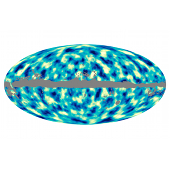Simon White Director of Max Planck Institut für Astrophysik giving today's Physics Colloquium at ACP on the Planck Results
Likely to be interesting, hence the semi-liveblog.
Starts with description of the collaboration and historical perspective; Penzias and Wilson, COBE and WMAP
Cute ESA video showing Planck science
Even better ESA video explaining stuff
Very good description of baryon acoustic oscillations and polarization.
Quick glimpse of stacked and normalized Planck measurements of tangential/radial polarization of cold/hot spots at ~ 1 degree scales.

Nice animation blinking weak lensed vs unlensed CMB
Very nice lensing mass map from ~ first year of data.
Good summary of Sunyaev-Zeldovich effect.
And here come the cosmological parameters...
Same as this spring: tilted spectrum suggesting inflation; flat universe; 3 neutrino species, total mass under 0.23 eV; W = -1 +/- 0.2
Everything looks gaussian, slightly less dark energy than pre-Planck estimates, H0 still on the low side...
Þór is disturbed
Long discussion of correlation in the CMB with mass maps
nice signature of dark matter and that baryons are tracing dark matter distribution #ButWhyDoWeNeverTalkABoutBiasAnymore ;-)
I ask about the H0 - HST key project/NGC4258 find it around 72 and Planck around 67
- word that the maser distances are coming down, big project to measure other extragalactic megamasers undwerway with prelim results pre-planck
NGC 4258 must have significant peculiar velocity relative to local flow (is my personal explanation - ought to be testable looking at surrounding attractors)
- 2.4% normalization offset between Planck and WMAP
source not yet understood, looks like some absolute calibration issue
looks worst at ~ 200 GHz
SPT data more consistent with Planck normalization
And now the anomalous spots... 2.5σ anomalies
maybe just function of looking for too many different anomalies... or cosmic variance... or...
- Log in to post comments






Will there be video (or at least the slides) of the talk posted at some point? Thanks for liveblogging!
ACP colloquia are not video'd - only the public lectures.
Don't have the resources to do the colloquia.
I'll ask about the slides
Thanks! I just found a megamaser H_0 paper (Reid et al. 2013, ApJ, 767, 154) which used UGC 3789 and finds H_0 = 68.9 +/- 7.1.
Why does local flow matters? NGC4258 is used to calibrate Cepheid P/L relation with maser distance. Neither is affected by the peculiar velocity of the galaxy.
Amazing. My post of valid scientific criticism is deleted within 1 min.
Just admit it: you made a mistake in your post.
Hubble constant is determined from Cepheids or SNe Ia in a number of galaxies. NGC 4258 is used as anchor point to calibrate Cepheid P/L relation with maser. Its peculiar velocity has no impact of the derived Hubble constant (from standard candles in other galaxies). Read Riess or Macri's papers.
Dear DistanceLadder
I did not delete your comment, they are auto-moderated by scienceblogs - I was on travel and and only just now logged in to check the comments held back.
Comment spam has overwhelmed all legitimate comments on the main blogs and has mostly destroyed blog discourse.
NGC 4258 is indeed used to cross-calibrate Cepheid P/L scale; it is in fact the case that the direct parallax distance is not used to tie down the distance scale through Hubble's Law because the peculiar velocity may be too large (cf Humphrey's et al 2013), and the new megamasers are coming up with somewhat smaller H0.
The question is how to reconcile the original NGC 4258 measurements since the formal errors are borderline significantly different from the new measurements.
It is not a big problem, but a niggling one and it would be good to understand the source of it - the Planck and WMAP cosmologies are just different enough that it may matter for astrophysical reasons.